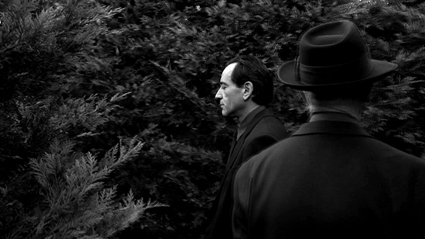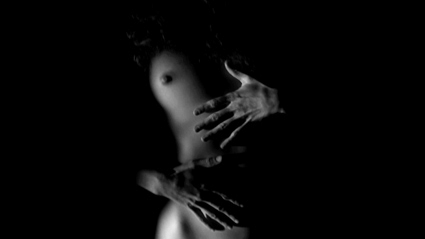memory & the haunted present
edward scheer: dennis del favero, magnesium light

Dennis Del Favero, Todtnauberg, 2009
video still, courtesy of the artist
Dennis Del Favero, Todtnauberg, 2009
PAUL CELAN, POSSIBLY THE GREATEST POST-WAR POET IN THE GERMAN LANGUAGE, WAS BORN A ROMANIAN JEW WHOSE PARENTS WERE MURDERED IN THE HOLOCAUST. HE HIMSELF SURVIVED NEARLY TWO YEARS IN THE LABOUR CAMPS THEN LIVED MOST OF HIS ADULT LIFE IN PARIS BEFORE COMMITTING SUICIDE IN 1970. HIS MOST FAMOUS POEM, TODESFUGE, OR DEATH FUGUE, WITH ITS IMAGERY OF THE “BLACK MILK OF DAYBREAK,” REMAINS A STARTLING, EVEN SHOCKING ELEGY FOR THE DEAD JEWS OF EUROPE.
Todtnauberg is the title of a less well-known but perhaps equally significant poem written shortly after Celan’s visit to the philosopher Martin Heidegger’s mountain retreat in the town of the same name as the poem in July 1967. The text recalls Celan’s inscription in Heidegger’s visitor’s book, expressing the longing for a word “from the heart” from the great thinker. Heidegger reportedly provided nothing of the kind. The meeting of a survivor of the Nazi regime and one of its most famous apologists is the subject of Dennis Del Favero’s video work, also titled Todtnauberg, which focuses on Celan imagining the conversation they might have had. It is one of two works that comprise Del Favero’s solo show, Magnesium Light, at Perth’s John Curtin Gallery.
The video is shot in subdued, black and white tones and evokes a certain melancholia as the figure makes his way through the woods (just as Celan and Heidegger walked through the woods together). Yet there is no attempt to represent the significance of the occasion. The monochromatic tones and short duration of the work recall the similar restraint of Celan’s poem (a single sentence in eight stanzas). The audio track relates the dream of Heidegger’s apology, the fantasy of a mutually felt disgust. Celan imagines their tears flowing together, expressing his hope that the thinker can reflect on the infinite suffering that resulted from his chosen political orientation. Heidegger’s voice is also heard as he goes on to say that their personal views are now irrelevant from the perspective of history…but the logic of this work is that this is clearly not the case. The work engages the selective memory of both participants: Heidegger’s ongoing silence about his support for the Nazis and Celan’s wishful thinking about Heidegger and his often expressed guilt about his own survival when so many died, including his own parents.
Jill Bennett has written beautifully about the function of memory and forgetfulness in Del Favero’s work: “memory is never simply a matter of recall, as Dennis Del Favero’s work persistently demonstrates. If trauma, pain and emotional distress must pass into the narrative of memory in order to become livable, these experiences do not bear constant replay. The work of narrative—and of the visual imaginary—is to process and house such memory in ways that enable transition, allowing remembering to occur at the same time as placing trauma (which haunts the present) in a past over which the narrator has some measure of control” (catalogue essay to Forgetful Sky, Boutwell Draper Gallery, Sydney 2009).

Dennis Del Favero, You and I, 2009
video still, courtesy of the artist
Dennis Del Favero, You and I, 2009
In the other work presented here, You and I, Del Favero explores this kind of displacement in the context of the infamous Abu Ghraib photographs of 2006. This is not immediately clear from the video which shows an anonymous woman writhing in sexual pleasure. A voiceover, with an American accent, suggests that the woman is a female soldier based somewhere in the Middle East. The video performs an act of displacement in which, as Bennett has pointed out, the woman chooses to overlook her abuse of a prisoner by focusing on the memory of her sexual conquest.
In Del Favero’s opus there is a consistent investigation of traumatic memory, memories that surface reluctantly if at all, seen in works such Cross Currents (1999), engaging with the experience of sex slaves, and Deep Sleep (2004), which deals with the artist’s own personal memories of treatment at Chelmsford Psychiatric Hospital in the 1970s. Most recently in Scenario (2011), an iCinema project directed by Del Favero and a world first interactive and immersive 3D cinematic experience, we see the same structure. His works all use new media devices to explore dimensions of memory interactively and to engage an audience with material that both wants to remain hidden but which continually rises forcefully to the surface of memory. Art has always played this role, to bring the unseen or overlooked into focus, and for Del Favero this is also a key function of his own new media art.
In the title of the work Pentimento (2002), which deals with a case of brother-sister incest, we can read a clue as to how Del Favero sees his work as the exploration of what art historians call ‘pentimenti,’ the visible traces of an earlier version of an artist’s layout beneath layers of paint on a canvas. Del Favero aims to activate the hidden dimensions of memory in society or the human psyche and, in this sense, the works in Magnesium Light show the dynamic nature of memory that refuses the logic of either simple loss or recall. These works show a memory that resists erasure but equally avoids the repetition of traumatic recall and forms instead the basis for a partly fantasmatic but entirely workable relationship with the self and the world.
The works in Magnesium Light may not look like user guides to an ethical life but they purport to explore the ways that victims and perpetrators of violence can refocus on how “one might live in a world increasingly haunted by its past” (Del Favero, artist statement, Australian Video Art Archive. www.videoartchive.org.au/dfavero). His art explores and performs the essential displacements and substitutions we all make in memory and so enables an ethical examination of our perspectives on such complex values as innocence and guilt. Magnesium Light complicates a reading of victimhood as innocence and a visual rendering of the perpetrator as an unfeeling “anaesthetic protuberance” (Susan Buck-Morss,”Aesthetics and Anaesthetics: Walter Benjamin’s Artwork Essay Reconsidered,” October 62, Fall 1992). In achieving this, the work enables a significant re-evaluation of the codes of trauma and memory in visual culture.
Dennis del Favero, Magnesium Light, John Curtin Gallery, Curtin University, Perth, June 1-Aug 5
RealTime issue #109 June-July 2012 pg. 44






